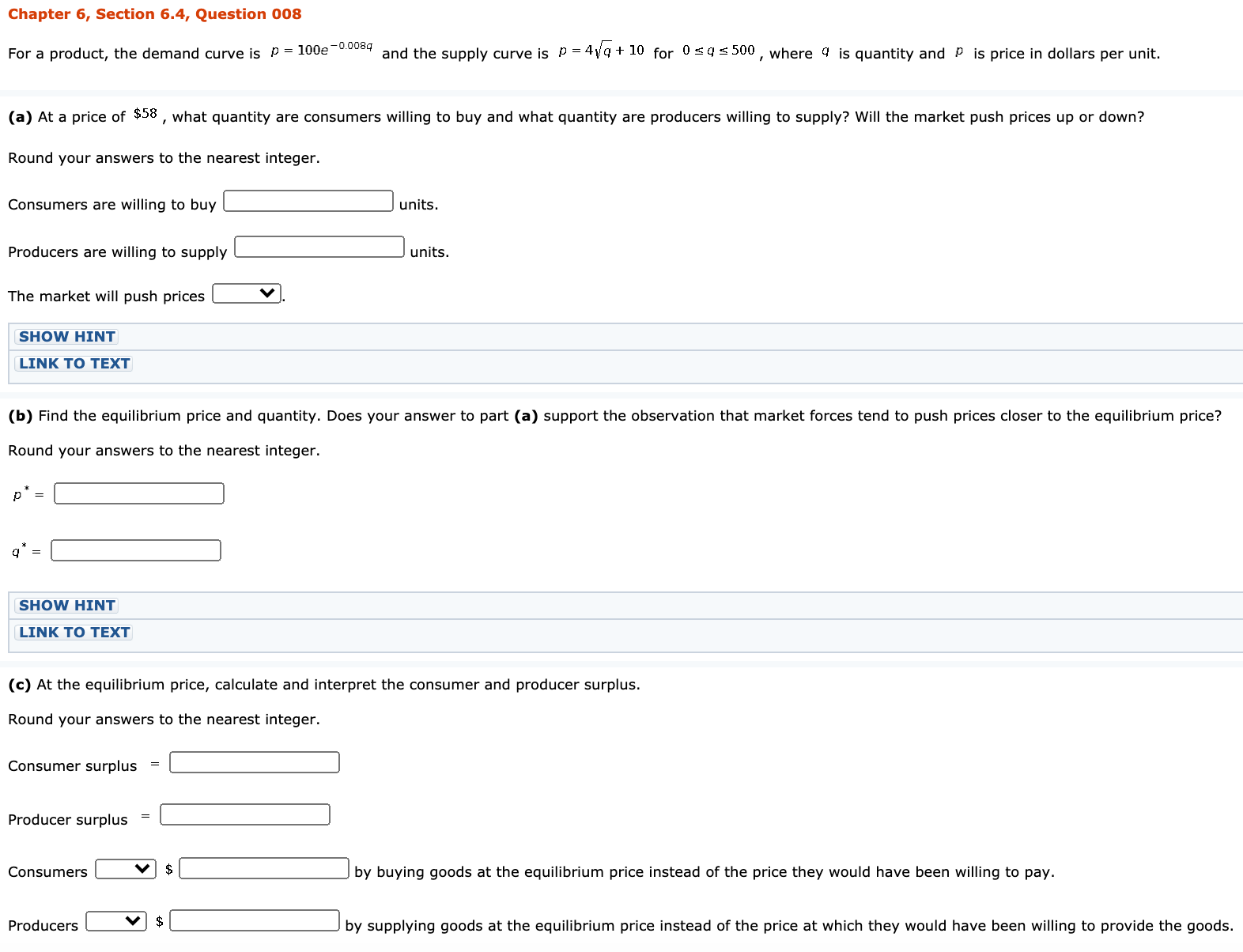Chapter 6, Section 6.4, Question 008 For a product, the demand curve is p = 100e-00084 and the supply curve is p = 4vg + 10 for 0sqs 500 , where 4 is quantity and P is price in dollars per unit. (a) At a price of $58 , what quantity are consumers willing to buy and what quantity are producers willing to supply? Will the market push prices up or down? Round your answers to the nearest integer. Consumers are willing to buy units. Producers are willing to supply units. The market will push prices SHOW HINT LINK TO TEXT (b) Find the equilibrium price and quantity. Does your answer to part (a) support the observation that market forces tend to push prices closer to the equilibrium price? Round your answers to the nearest integer. p = SHOW HINT LINK TO TEXT (c) At the equilibrium price, calculate and interpret the consumer and producer surplus. Round your answers to the nearest integer. Consumer surplus Producer surplus Consumers $ by buying goods at the equilibrium price instead of the price they would have been willing to pay. Producers $ by supplying goods at the equilibrium price instead of the price at which they would have been willing to provide the goods
Chapter 6, Section 6.4, Question 008 For a product, the demand curve is p = 100e-00084 and the supply curve is p = 4vg + 10 for 0sqs 500 , where 4 is quantity and P is price in dollars per unit. (a) At a price of $58 , what quantity are consumers willing to buy and what quantity are producers willing to supply? Will the market push prices up or down? Round your answers to the nearest integer. Consumers are willing to buy units. Producers are willing to supply units. The market will push prices SHOW HINT LINK TO TEXT (b) Find the equilibrium price and quantity. Does your answer to part (a) support the observation that market forces tend to push prices closer to the equilibrium price? Round your answers to the nearest integer. p = SHOW HINT LINK TO TEXT (c) At the equilibrium price, calculate and interpret the consumer and producer surplus. Round your answers to the nearest integer. Consumer surplus Producer surplus Consumers $ by buying goods at the equilibrium price instead of the price they would have been willing to pay. Producers $ by supplying goods at the equilibrium price instead of the price at which they would have been willing to provide the goods
Linear Algebra: A Modern Introduction
4th Edition
ISBN:9781285463247
Author:David Poole
Publisher:David Poole
Chapter2: Systems Of Linear Equations
Section2.4: Applications
Problem 6EQ: Redo Exercise 5, assuming that the house blend contains 300 grams of Colombian beans, 50 grams of...
Related questions
Topic Video
Question

Transcribed Image Text:Chapter 6, Section 6.4, Question 008
For a product, the demand curve is p = 100e-00084 and the supply curve is p = 4vg + 10 for 0sqs 500 , where 4 is quantity and P is price in dollars per unit.
(a) At a price of $58 , what quantity are consumers willing to buy and what quantity are producers willing to supply? Will the market push prices up or down?
Round your answers to the nearest integer.
Consumers are willing to buy
units.
Producers are willing to supply
units.
The market will push prices
SHOW HINT
LINK TO TEXT
(b) Find the equilibrium price and quantity. Does your answer to part (a) support the observation that market forces tend to push prices closer to the equilibrium price?
Round your answers to the nearest integer.
p =
SHOW HINT
LINK TO TEXT
(c) At the equilibrium price, calculate and interpret the consumer and producer surplus.
Round your answers to the nearest integer.
Consumer surplus
Producer surplus
Consumers
$
by buying goods at the equilibrium price instead of the price they would have been willing to pay.
Producers
$
by supplying goods at the equilibrium price instead of the price at which they would have been willing to provide the goods
Expert Solution
This question has been solved!
Explore an expertly crafted, step-by-step solution for a thorough understanding of key concepts.
This is a popular solution!
Trending now
This is a popular solution!
Step by step
Solved in 4 steps with 2 images

Knowledge Booster
Learn more about
Need a deep-dive on the concept behind this application? Look no further. Learn more about this topic, calculus and related others by exploring similar questions and additional content below.Recommended textbooks for you

Linear Algebra: A Modern Introduction
Algebra
ISBN:
9781285463247
Author:
David Poole
Publisher:
Cengage Learning

Algebra for College Students
Algebra
ISBN:
9781285195780
Author:
Jerome E. Kaufmann, Karen L. Schwitters
Publisher:
Cengage Learning

Linear Algebra: A Modern Introduction
Algebra
ISBN:
9781285463247
Author:
David Poole
Publisher:
Cengage Learning

Algebra for College Students
Algebra
ISBN:
9781285195780
Author:
Jerome E. Kaufmann, Karen L. Schwitters
Publisher:
Cengage Learning